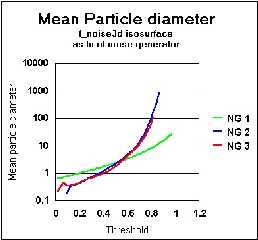 |
 |
|
 |
|
 |
|  |
|  |
|
 |
From: Greg M Johnson
Subject: Mean particle diameter of f_noise3d isosurface
Date: 1 Sep 2002 23:11:49
Message: <3d72d6f5$1@news.povray.org>
|
|
 |
|  |
|  |
|
 |
I've been exploring the f_noise3d function to try to get a grasp for what's
really different between noise_generators 2 and 3. The following plot is
the "mean particle diameter". At low thresholds, it's self-explanatory. At
high tresholds, it's best understood as the "mean free path" in the material
until you hit a "pore".
Here, noise_generator 1 really splits from the pack. You see the evidence
of the "plateuas," in that for infitesimal differences from either 0 or 1
you have a handful of particles.
Post a reply to this message
Attachments:
Download 'mean.jpg' (47 KB)
Preview of image 'mean.jpg'

|
 |
|  |
|  |
|
 |
|
 |
|  |
|  |
|
 |
Greg, Have you thought about donating your findings to the documentation
shipped with Pov-Ray ? Bill P.
> I've been exploring the f_noise3d function to try to get a grasp for what's
> really different between noise_generators 2 and 3. The following plot is
> the "mean particle diameter". At low thresholds, it's self-explanatory. At
> high tresholds, it's best understood as the "mean free path" in the material
> until you hit a "pore".
>
> Here, noise_generator 1 really splits from the pack. You see the evidence
> of the "plateuas," in that for infitesimal differences from either 0 or 1
> you have a handful of particles.
>
> [Image]
Post a reply to this message
|
 |
|  |
|  |
|
 |
From: Greg M Johnson
Subject: Re: Mean particle diameter of f_noise3d isosurface
Date: 2 Sep 2002 09:04:02
Message: <3d7361c2$1@news.povray.org>
|
|
 |
|  |
|  |
|
 |
Yes, if they'd take it.
In thinking more about my calcs, I'm purely confident the volume fraction
calc is based on correct metallographic principles. This calc, however, of
the mpd is based on a 2-d measurement, and the 2d measurement doesn't
exactly represent the 3d. So please don't use these results for any legal
work or building a bridge on which human beings will have to travel for the
time being...
I also would think that I'm not finished until I can find a
"metallographic", quantitative, difference between NG2 and NG3. I know
that mountains "look different," but not what makes them different. (Don't
say 1/f noise or I'll yawn and shrug my shoulders as to what the heck you're
saying).
"William F. Pokorny" <pok### [at] attglobal net> wrote in message
news:3D734F23.8215AC5C@attglobal.net...
> Greg, Have you thought about donating your findings to the documentation
> shipped with Pov-Ray ? Bill P.
> net> wrote in message
news:3D734F23.8215AC5C@attglobal.net...
> Greg, Have you thought about donating your findings to the documentation
> shipped with Pov-Ray ? Bill P.
>
Post a reply to this message
|
 |
|  |
|  |
|
 |
|
 |
|  |
|  |
|
 |
in news:3d7361c2$1@news.povray.org Greg M. Johnson wrote:
> Yes, if they'd take it.
>
Greg,
I have both threads bookmarked, in one of my Doc folders, as something
usfull and interesting without having an idea of wether or not, or where,
it will fit in the documentation.
Ingo
Post a reply to this message
|
 |
|  |
|  |
|
 |
|
 |
|  |
|
 |




![]()